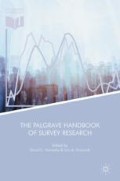Abstract
Understanding how well a sample of respondents represents the larger population from which is was drawn is critical to being able to generate valid inferences about the population. Probability-based sampling approaches have been a theoretical and empirical cornerstone of high-quality research about populations. However, non-probability sampling methods, such as those applied with the vast majority of opt-in survey panels, increasingly are being used to draw inferences about populations. This chapter examines critical issues that researchers need to be aware of when comparing these different approaches to sampling in their own work and when evaluating the work of others, and highlights the need for particular scrutiny of work produced using non-probability samples.
References and Further Reading
Baker, R. (2009). Finally, the Real Issue? Retrieved 2009, from http://regbaker.typepad.com/regs_blog/2009/07/finally-the-real-issue.html
Baker, R., Blumberg, S. J., Brick, J. M., Couper, M. P., Courtright, M., Dennis, J. M., et al. (2010). Research Synthesis: AAPOR Report On Online Panels. Public Opinion Quarterly, 74(4), 711–781. http://doi.org/10.1093/poq/nfq048
Callegaro, M., Villar, A., Krosnick, J. A., & Yeager, D. S. (2012). A Systematic Review of Studies Investigating the Quality of Data Obtained with Online Panels. Presented at the Annual Meeting of the American Association for Public Opinion Research, Orlando, FL.
Gallup, G. H., & Rae, S. F. (1940). The Pulse of Democracy: The Public Opinion Poll and How it Works. New York: Simon and Schuster.
Gilbert, J. P., Light, L. R., & Mosteller, F. (1977). Assessing Social Innovations: An Empirical Base for Policy. In W. B. Fairley (Ed.), Statistics and Public Policy. Reading, MA: Addison-Wesley Pub Co.
Kish, L. (1965). Survey Sampling. New York: John Wiley & Sons, Inc.
Pasek, J., & Krosnick, J. A. (2010). Measuring intent to participate and participation in the 2010 Census and their correlates and trends: Comparisons of RDD telephone and nonprobability sample. Survey Methodology.
Yeager, D. S., Krosnick, J. A., Chang, L., Javitz, H. S., Levendusky, M. S., Simpser, A., & Wang, R. (2011). Comparing the Accuracy of RDD Telephone Surveys and Internet Surveys Conducted with Probability and Non-Probability Samples. Public Opinion Quarterly, 75(4), 709–747. http://doi.org/10.1093/poq/nfr020
Author information
Authors and Affiliations
Corresponding author
Editor information
Editors and Affiliations
Rights and permissions
Copyright information
© 2018 The Author(s)
About this chapter
Cite this chapter
Langer, G. (2018). The Importance of Probability-Based Sampling Methods for Drawing Valid Inferences. In: Vannette, D., Krosnick, J. (eds) The Palgrave Handbook of Survey Research . Palgrave Macmillan, Cham. https://doi.org/10.1007/978-3-319-54395-6_2
Download citation
DOI: https://doi.org/10.1007/978-3-319-54395-6_2
Published:
Publisher Name: Palgrave Macmillan, Cham
Print ISBN: 978-3-319-54394-9
Online ISBN: 978-3-319-54395-6
eBook Packages: Political Science and International StudiesPolitical Science and International Studies (R0)

